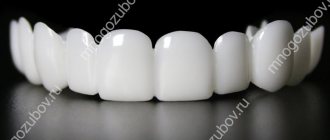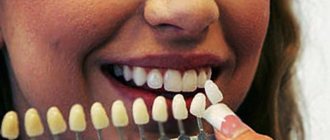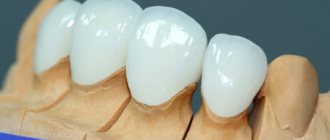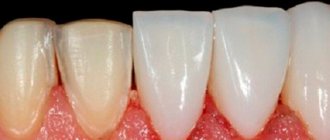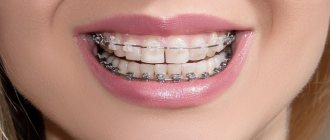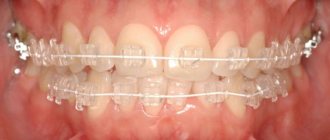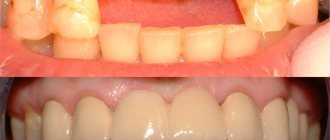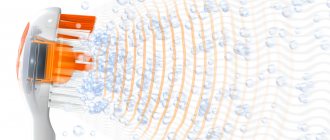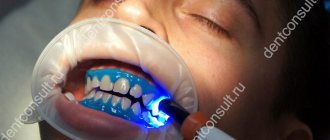Dental veneers are a type of prosthetics that covers the front part of the tooth. As a result, it looks much more aesthetically pleasing. Dental veneers are microprostheses. With their help, you can restore the shape and color of one tooth or a whole row.
Restoration with veneers involves fixing them to the front part of the tooth. They are used to restore the appearance of teeth that fall into the smile line.
The best veneers are virtually indistinguishable in appearance from real teeth. Their color is selected to match the natural one.
In dentistry, veneers are used when whitening or restoring enamel by other methods does not provide the desired effect. Restoration is carried out as soon as possible.
What are temporary veneers, why get them and how long will you have to wear them?
Today, installing veneers that make a smile attractive is a procedure that is available to everyone. And almost a century ago, only Hollywood actors could afford them, and even then not for long - only for the period of time while filming took place. Celebrity stylists put thin plates on the teeth as a kind of make-up or disguise defects, and glued them with a temporary composition. After 1-2 days, such overlays were removed. Today, high-quality veneers that are installed in dental offices are permanent structures that serve their owners for 5-7 or more years (depending on the properties of the selected material). However, on the Internet you can find information about removable veneers. What are these structures? Find out more in our article today!
Recovery and rehabilitation period
You should not eat until the anesthesia wears off after the veneers are installed. Don't bite or chew anything. Also, after the procedure, a combination of taking hot and cold together is not recommended.
You should definitely come for a preventive examination. Your doctor should schedule a date for you to check that your teeth are aligned correctly.
If you have problems such as bruxism or malocclusion, you should wear special protective mouth guards. Also, do not neglect preventive examinations. Another important point is that after installing veneers, you should periodically perform oral hygiene (2 times a day or after each meal).
What are veneers
Veneers are very thin shells made of composite material, zirconium dioxide or ceramic. They are glued to the filed enamel surface with special cement in order to make the patient's front teeth ideal, i.e. hide all external cosmetic defects and imperfections: chips, cracks, unsightly shade, fillings, diastema, slight curvature.
Read more about what veneers are in a specially prepared article on the website.
This orthopedic solution has its pros and cons. For example, its advantages include high aesthetic results and low trauma during installation compared to crowns. And among the disadvantages is a fairly high price. Also, do not forget that grinding the enamel before installing veneers is still necessary, and this process is irreversible, because After removal, the teeth will no longer look the same as before.
Start of the process
The installation of veneers begins with treatment of the oral cavity - sanitation. If you place them on an unprepared surface, inflamed gums and incisors affected by caries, then after some time the structure will intensify destruction and lead to the rapid proliferation of infection.
If a veneer is placed on the filling area, then the cement composition is changed, otherwise there will not be sufficient adhesion strength of the prosthesis to the surface.
An X-ray examination is also required, which reveals underlying processes of damage to the gums, nerves, and pulp. After preparing the mouth for the installation of mini-dentures, they begin to choose the color. This stage must be performed before turning, so that it is possible to determine the shade of the native enamel. It is selected according to a special dental scale.
If 1 new incisor is installed, the color of the veneer should match the rest as closely as possible. If parts are installed on all the front teeth, then the client chooses the shade as desired.
Preparation and preparation of the impression
Preparation is the grinding of a tooth, as a result of which the incisor acquires an ideal shape for installing a mini-prosthesis. A layer of enamel is removed from 0.5 to 0.7 mm. The procedure requires anesthesia.
When the incisors are prepared, the dentist makes an impression using a special compound. The finished impression is sent to the laboratory for subsequent diagnosis and production of veneers.
Temporary dentures
To prevent the patient from experiencing discomfort, the doctor places temporary veneers:
- needed for 1-2 weeks while permanent parts are being manufactured;
- sensitive enamel that has been ground does not allow you to properly brush your teeth and eat;
- sharpened incisors often become sharp and injure the gums and tongue.
Grinding is used if veneers are made using indirect technology (zirconium, porcelain). If the direct method is used, then linings made of composite material are placed immediately in the mouth. However, such a substance does not have the proper strength and is used when there is no possibility of installing other types of veneers.
Indirect technology
After the plates are made, they are tried on the patient’s teeth. If modifications are necessary, the part is sent back to the laboratory and corrected. When the veneer fits perfectly, it is placed using a dental reflective substance and the doctor evaluates the patient's bite.
Is it possible to install mini-dentures without damaging the enamel?
Grinding is necessary because the thickness does not allow the linings to be placed properly: they layer on top of each other, make the jaw heavier, and contribute to gum inflammation. If the defects are very minor, then ultra-thin lumineers can be installed - they do not require grinding down the enamel. However, they cannot be placed if the teeth are too crooked or severely damaged.
Features of adhesive for installation
Before placing veneers, the dentist treats their inner surface with a special mixture (the procedure is not required when installing ceramics layer-by-layer). Then the enamel is degreased and an etching gel is applied.
After 3 minutes, the gel is washed off, the surface is dried with air and the dental substance is applied to the inside of the veneer and the outside of natural teeth. For fixation, each element is illuminated with a dental lamp.
After all the veneers have been treated with a lamp, the dentist removes excess gel and polishes the transition zones into artificial plates so that they are not noticeable. If the patient feels severe discomfort when moving, the plates are further processed.
The gel that adheres the veneers to the surface consists of beneficial minerals. They strengthen native enamel and promote bone tissue restoration.
What are removable veneers and what are they for?
These are temporary overlays or caps made of plastic that the doctor installs on the teeth after preparing the enamel and taking impressions. The fact is that permanent veneers still need to be made in a dental laboratory so that they recreate the anatomy of the patient’s natural teeth as accurately as possible and look natural. The production of onlays can take from 1 week to a month, it all depends on the workload of the laboratory. During this period of time, the ground enamel does not look very aesthetically pleasing, and without temporary overlays it will also remain defenseless against external influences: bacteria, plaque, temperature and hardness of food.
To protect the ground enamel, doctors resort to the use of removable veneers. The plates are made of plastic and attached with glue, which, however, can be easily removed in the dental office. Such onlays allow you to protect your teeth while the patient is waiting for a follow-up appointment with the orthopedist.
Lumineers: indication and installation
This type of veneers, called lumineers, is installed when the patient has minor injuries:
- cracks and small chips without damaging bone tissue - lumineers will protect teeth from infection and further destruction;
- spots and darkening, especially with fluorosis;
- darkened or stained fillings on the front teeth;
- small gaps - lumineers are placed if the patient does not want to wear braces or use other systems to straighten the row;
- tendency to thinning enamel - lumineers ideally protect it and prevent destruction;
- severe erosions similar to caries or dark brown spots;
- underdevelopment of individual teeth;
- congenital yellowness of teeth that cannot be corrected by professional cleaning and whitening.
The cost of installing lumineers will be somewhat more expensive, since the manufacturing technology of these structures is more complex. The finished part is up to 0.5 mm thick (plus or minus 0.2-0.3 mm).
Lumineers are installed in almost the same way as veneers, only the stage of grinding the teeth is skipped. Sometimes a computer is used to design a smile: a 3D model of teeth is created instead of a dental cast.
Many lumineers are made in America, so the process takes from 1 month. But since there is no need to grind down the enamel, the waiting period does not in any way affect the patient’s well-being.
After production, lumineers are tried on - the technology is so precise that modifications are required only in 1-5% of cases. If it is needed, the lumineers are ground in a local laboratory. Before removing the 3D model, the patient’s oral cavity is also examined, and then treatment is prescribed if there is caries or other inflammation.
Micro-dentures are placed on teeth treated with a special solution using modern dental glue. The process of processing enamel is called etching - it is not traumatic. Installation of the thinnest plates is a safe and comfortable procedure for the patient; in rare cases, painkiller injections are required (in case of increased sensitivity).
Perfect Smile overlay veneers
By removable veneers, dentists mean temporary overlays that protect the patient’s teeth from external influences for that period of time until permanent ones are made. However, today on the Internet you can find offers from various online stores in which users are told about the advantages of inexpensive overlay veneers. For example, Perfect Smile from the USA. Manufacturers claim that this miracle product allows you to achieve an ideal snow-white smile for a while and does not require you to make any sacrifices at all, i.e. allow you to do without grinding the enamel.
But let’s look at their main advantages from the manufacturer’s point of view, and then the disadvantages from the point of view of deceived buyers who have already fallen for the tricks of marketers advertising this product and many beautiful pictures. We will also find out the opinion of professional dentists on this matter.
The manufacturer claims that such devices are universal and are suitable for absolutely all people who need to look irresistible at some event (wedding, business meeting, photo and video shooting). The essence of this method is simple: temporary products are put on the teeth like a mouthguard, and are held securely due to the chemical properties of the material.
To use these veneers, you need to heat them in boiling water for a few minutes, then remove them using a clean cutlery, let them cool slightly and place them tightly on the upper or lower teeth. This is done so that the inside of the veneers adapts to the individual structure of the dentition. After which the pad is removed and placed in a glass of cold water. After the outer side of the veneers turns snow-white, they are placed on the teeth and worn.
Important! Although temptingly cheap, such overlay plates have several significant drawbacks. For example, they do not have an individual design, they do not take into account the structure of the oral cavity, which means they may be uncomfortable to wear. Besides, they look unnatural. In addition, they have to be removed before each meal, otherwise they quickly become unusable.
It would seem that in the head of someone who is going to buy overlays, an ideal image is created. However, in reality everything turns out to be not so beautiful. Plastic or propylene products that people received by mail, after placing them in boiling water, immediately stuck to their teeth, but as soon as they cooled down, they instantly fell off, i.e. They don't stay in the mouth at all. Users also note that they have an unpleasant taste and smell of plastic, like any cheap Chinese product. Plus, the onlays did not fit the size of the teeth, because, of course, they are templates, and at the same time they are not made in a jewelry manner.
Dentists and orthopedists are of the same opinion: if you want to solve dental problems, go to a professional doctor, and do not buy masquerade toys that have a dubious composition. Not only will they not make your smile attractive, but they can also negatively affect your health, because no one rules out the toxicity of the material from which these products are made. In addition, you need to use common sense and understand that pads that are fixed to the water are nonsense.
Intraoral scanner ensures optical accuracy of aligners
To make the aligners, we used an intraoral scanner, which was used to take optical impressions. That is, the camera takes many pictures, which are stitched into a 3D image in a special program. And this 3D image is sent to the laboratory, bypassing transport and time losses, bypassing shrinkage and all kinds of force majeure circumstances - hypothermia of the impression masses. Accordingly, we get a more accurate, more predictable result.
Anna
: The teeth scanning took place there for 15 minutes. And a week later, at a follow-up appointment, I was able to immediately see how my teeth would move.
Doctor Arkashov
: That is, by the time we received the result from the laboratory with the final treatment plan, we had not yet done anything to our patient. The result that we get after aligners will be appreciated by the patient. And we, as a rule, allow you to look at the result of orthodontic treatment. And many patients are satisfied with it.
How removable veneers are made and applied
Since the installation of temporary plates is one of the stages of prosthetics, they are made on the basis of the same impression that is made for turning permanent dentures. This allows you to create a product based on an individual layout, as well as correct shortcomings that are revealed during the installation of temporary veneers.
On a note! Sometimes on the Internet you can find information that composite veneers are called removable, which the doctor can install on the teeth in just one visit through layer-by-layer application of the composite, and, if necessary, also quickly remove or make corrections. However, in relation to composite onlays, terms such as “removable” or “temporary” cannot be used, because With careful care they can last 3-5 years.
To attach the plates, the doctor uses special cement, which will provide strong adhesion and protection from thermal effects, but can be easily removed from the tooth by the dentist.
For what purposes do dentists use veneers?
Dentists use veneers for dental prosthetics. Unlike a crown, they are placed only on the front part of the tooth, hiding its flaws. Teeth with onlays look both aesthetically pleasing and natural.
If other restoration work has not produced the desired effect, and the patient wants to look different with a more beautiful smile, custom dental veneers are also used. The dentist can also prescribe them if there are large gaps between the teeth. In the clinic, onlays can be fixed to both the lower and upper teeth.
Veneers for aesthetics
Veneers can make your smile look great. At the same time, it can look natural. Veneers on the front teeth can change their color, which has deteriorated after root canal treatment and the use of tetracycline. They are also excellent for correcting short, misshapen teeth. To do this, veneers are fixed to crooked teeth.
You can install veneers to eliminate gaps between teeth and solve the problem of a gummy smile. Overlay veneers can also help if there is weak muscle tone in the lower area of the face and skin. The color of veneers is selected individually in each case. When installed on chewing teeth, you can achieve a lifting effect for the cheekbones. Even if there is one problematic front tooth, this problem can be easily solved.
Functional purpose of veneers
The use of veneers can correct not only aesthetic problems, but also bite problems. In this case, we are talking about the incorrect relationship of the teeth. This is what needs to be corrected.
Microprostheses will allow you to make your jaw look correct. They are able to adhere well and eliminate various defects, including cracks in the teeth, uneven rows, and existing gaps.
Is it worth putting veneers on the weight of the teeth? Theoretically, this is possible, but most often they are fixed only on the smile line - 8 lower and 10 upper teeth.
Contraindications for installation
These include:
- Extreme hobbies with a high probability of dental damage.
- Inability to give up bad habits, such as chewing nuts and nails.
- Bruxism.
- A large filling on the inner surface of the tooth.
- Loss of chewing teeth.
- Severe changes in bite.
- Dental diseases.
Before installing any veneers, preparation of the oral cavity is required. Caries is eliminated; if there are inflammatory processes, they also need to be eliminated.
Why does conventional veneer placement disappoint patients?
Beautiful and durable veneers can only be made taking into account the characteristics of the patient’s bite, muscles and joints. For example, if a patient grinds his teeth or clenches them tightly in his sleep, there is a high probability of chips on the plates. Therefore, before making restorations, it is necessary to conduct a thorough diagnosis and, if necessary, restore the balance between the joints, muscles and teeth for the proper functioning of the dentofacial apparatus. And only after that restore the teeth. This approach guarantees the following advantages:
✔
Veneers will last for many years
✔
The smile will be harmonious and natural
✔
The lower third of the face will be tightened without plastic surgery
Product benefits or why people buy veneers
- Versatility: 1 size for everyone.
- Practicality: the device can be used in any situation.
- Ease of operation: storage of plates does not require special conditions.
- Strength: polypropylene is resistant to mechanical damage.
- Comfort: removing and attaching the product is very easy.
- Safety: the product is made of hypoallergenic material that is harmless to humans.
- Profitability: low price and long service life.
- Naturalness: there is no feeling of an artificial jaw.
Content
- Indications for installation
- Contraindications
- Classic veneers
- Composite veneers
- Complications
The method of installing veneers depends on their type. Classic veneers, composite veneers, and lumineers are used. They are often placed on teeth located in the smile zone - the front 8-10 teeth. The number of plates installed depends on the characteristics of the individual patient, the size of the teeth, etc. You can install veneers on only the upper jaw or on both. Plates are also installed on single teeth if necessary. In this case, there is a high probability that the restored tooth will stand out from the crowd. For example, if the installation is planned on a central incisor, it is best to install veneers on both teeth.
Who needs the product
Videos in Russian and English about the product, as well as new reviews, regularly appear on the Internet. According to the material presented there, the main indication for the purchase and use of veneers is the imperfection of one’s own smile. The removable design perfectly masks the following defects:
- large gaps between teeth;
- crooked lower or upper rows of teeth;
- missing one or more teeth;
- chips and cracks;
- darkened enamel;
- gummy smile.
The product will help hide a number of dental procedures: installation of crowns, extension and correction of front incisors, replacement of dentures. There are a lot of videos on the Internet about how overlays have helped transform your appearance.
